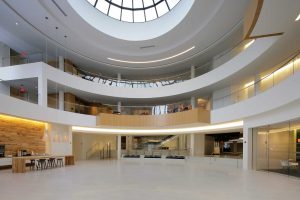
Grant Caldwell
by Grant Caldwell
As the economy in Boston continues to surge, the demand for innovative and inspiring workspaces is growing exponentially. Boston has attracted some of the world’s leading companies in technology, finance, and business who are all competing for top talent on a global level. In addition to the massive influx of new construction in the Seaport District that many of these new-to-Boston companies are calling home, many are also occupying existing spaces, requiring complete gut renovations of tens and even hundreds of thousands of square feet. In addition, many existing Boston-based companies are completing extensive renovations to stay on the competitive edge.
The modern-day workspace has changed dramatically from the old miles of rows of cubicles surrounded by private executive offices and conference rooms. You no longer step off the elevator into a dull lobby with the ordinary finishes of the past. Today, businesses want open areas where employees can collaborate and share ideas and information. They want bright, loud spaces that inspire excitement and innovation. Employees no longer gather around the water cooler, they gather around the coffee bar or in the lounge or café. Demand for talented employees is fierce, and tenant interior spaces are being designed to offer comforts and amenities that you would not have dreamed of seeing in a work place years ago.

Lobby at Mathworks
Businesses have focused their attention on creating workspaces that are designed for the employee and have hired the top architects and designers to do so. The competition for progressively more custom and unique designs has opened the floodgates, and tenant interior projects are filled with millions, and often tens of millions, of dollars of custom millwork features and specialty items. With this ever-changing list of specialties, construction managers are at a loss for qualified subcontractors and are turning to the millwork firms to group all of these finishes into one package.
Over the years, the scope of an architectural millwork package has changed and become much more diverse. At one point, the average millwork scope would consist of primarily wood products, such as trim, doors, cabinets, wall panels, and countertops. Today, the millworker is called on to provide a vast variety of specialty items including glass products, decorative metals, stone, acrylic, decorative and functional fabrics, operable partitions, and much more. Design trends have changed, and high-end tenant interior spaces now require more integration of a much larger variety of products and materials.
Looking back, there is also a definitive line in the trends of certain materials and designs. Similar to the trends in the names of new babies, it is not uncommon to have a handful of massive millwork projects get awarded simultaneously with the exact same wood species. Currently, rift white oak is extremely popular, where a few years back it was common to see plain sawn maple. Plastic laminate countertops were also once the standard in corporate offices, where now it is more common to see solid surface (i.e., Corian) and stone or quartz. Manufacturers and suppliers of these products are often switching gears to keep up with quickly shifting demands.
Architectural millwork firms are also constantly faced with learning about new products: how they react to custom fabrication, and how well they do, or do not, integrate with other materials. In addition, many of these products cannot be manufactured with traditional techniques and machinery. The bar has been raised, and the group that can compete at this level of quality, complexity, and size, while working within unimaginable time constraints, is very small in the Boston market.
It is truly an exciting time to be part of one of the hottest construction markets in the world. Businesses are making large investments into their office spaces, and world-class architects and designers are being set loose. Few millwork firms can keep up with their demands for the highest level of quality, and even fewer have the ability to execute their cutting-edge designs. The elite few that are capable, are honored with once-in-a-lifetime opportunities to create some of the most impressive tenant interior spaces ever produced.










